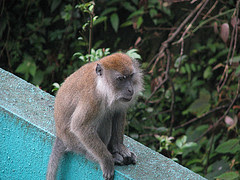 Chameleons (family Chamaeleonidae) are squamates that belong to one of the best-known lizard families. The name "chameleon" means "Earth lion" and is derived from the Greek words chamai (on the ground, on the earth) and leon (lion).
Chameleons (family Chamaeleonidae) are squamates that belong to one of the best-known lizard families. The name "chameleon" means "Earth lion" and is derived from the Greek words chamai (on the ground, on the earth) and leon (lion).
The chameleon in this post is known as Green Crested Lizard (Bronchocela Cristatella).

Chameleon changing of colour
Some chameleon species are able to change their skin colour, which has made them one of the most famous lizard families. Changing colour is an expression of the physical and physiological condition of the lizard. The colour also plays an important part in communication.
Despite popular belief, chameleons cannot change colour to their surroundings. Chameleons are naturally coloured for their surroundings as a camouflage.
Chameleons have specialized cells, collectively called chromatophores, that lie in layers under their transparent outer skin. The cells in the upper layer, called xanthophores and erythrophores, contain yellow and red pigments respectively. Below these is another layer of cells called iridophores or guanophores, and they contain the colourless crystalline substance guanine. These reflect, among others, the blue part of incident light. If the upper layer of chromatophores appears mainly yellow, the reflected light becomes green (blue plus yellow). A layer of dark melanin containing melanophores is situated even deeper under the reflective iridophores. The melanophores influence the 'lightness' of the reflected light. All these different pigment cells can rapidly relocate their pigments, thereby influencing the colour of the chameleon.
Click Chameleon gallery for more hi-res photos of chameleon (earth lion).
Technorati Tags: Chameleon, Earth Lion




















